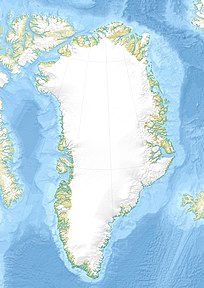Etah (Greenland)
| Iita | ||
|---|---|---|
| Etah Îta | ||
| Commune | Avannaata Communia | |
| District | Qaanaaq | |
| Geographical location | 78 ° 18 '36 " N , 72 ° 38' 54" W | |
|
|
||
| Residents | 0 (1953) |
|
| Time zone | UTC-3 | |
Etah ( Greenlandic Iita [ ˌiːˈta ]) is a deserted Greenlandic settlement in the district of Qaanaaq in the Avannaata Kommunia .
location
Etah is located on the north coast near the mouth of the Iitap Kangerlua (Foulke Fjord). The fjord is around eight kilometers long and around two kilometers wide at its mouth. The cliffs on both sides reach a height of around 700 meters. The fjord is fed by Brother John Gletsjer , at the end of which is Alida Sø, which is frozen almost all year round . The polar night lasts four months in Etah, from October 22nd to February 21st. [Document?] There are abundant hunting grounds in the vicinity of Etah, for example there are many walruses . [Proof?] The nutrient-rich water of Foulke Fjord is the food source of many small organisms, which is why large colonies of birds breed on the rocks of the fjord, which the Inuit have always hunted with nets. [Proof?] The comparatively large food supply in the area around Etah is the reason why the place was settled at all despite its extremely northern location and its extremely inhospitable climate. [Evidence?] The nearest place still inhabited today is Siorapaluk 75 km southeast. Siorapaluk is now the northernmost village in Greenland.
history
The name "Etah" given by Isaac Israel Hayes around 1860 has no known meaning. [Proof?] With its location, Etah was the northernmost natural settlement in the world until it was abandoned as a permanent settlement in 1953 . About 24 kilometers further north, however, were the previously abandoned settlements Anoritooq and Inuarfissuaq (78.8725 ° N 69.2183W), and a little further north were Qaqaatsut (79.2 ° N) and the settlement Nunataaq (80.0 ° N).
Originally Etah was on the south side of the fjord. The living space was later moved to its current location. In Danish, the two places are also known as Gamle Etah ("Old Etah") and Ny Etah ("New Etah"). [Receipt?]
Around 1900 Etah was the starting point of several North Pole expeditions. The polar explorer Donald Baxter MacMillan , who had already taken part in Robert Edwin Peary's pole expedition in 1908/09, made Etah the base for exploring the Greenland coast, the Ellesmere , as head of the Crocker Land Expedition from 1913 to 1917. Insel and the Axel-Heiberg-Insel . In 1927 he wrote the book Etah and Beyond . The Humphrey Expedition (1934–35), MacGregor's Arctic Expedition 1937/38 and the Haig Thomas Expedition of 1938 also began from Etah .
In 1951 Etah had 20 residents. In 1952 there were only nine left and the following year Etah was given up. The place had a shop, but no church or school. When a family of nine wintered in Etah around 1960, the place was no longer permanently populated. An attempt in 1984 to repopulate the place constantly failed. Today, the three or four remaining, somewhat dilapidated dwellings on Etah are only used in summer as a base for hunts and as a destination for polar tourists. [Receipt?]
literature
- Donald Baxter MacMillan : Etah and beyond. Or Life within Twelve Degrees of the Pole . Houghton Mifflin Company, Boston 1927 (additionally published as an article in The Geographical Journal July 1928. Vol. 72, No. 1, pp. 79-80).
- Clifford J. MacGregor : The MacGregor Arctic Expedition to Etah, Greenland, July 1, 1937 to October 4, 1938 . 1939 ( online [PDF]).
- David L. Sallach : NJ Historical Commission Newsletter . 1977.
- Hal Vogel : Ice Cap News . 1977.
- Hal Vogel: They Brought Their Own Storms . 1977.
Individual evidence
- ↑ Map with all official place names confirmed by Oqaasileriffik , provided by Asiaq
- ↑ Jens Christian Madsen: Udsteder og bopladser i Grønland 1901-2000 . Atuagkat, 2009, ISBN 978-87-90133-76-4 , pp. 204 ff .

